Archived Fire Damage Blog Posts
Our Approach to Fire Damage Mitigation
8/1/2024 (Permalink)
 A bedroom that was overseen by our project manager, Kevin Moon.
A bedroom that was overseen by our project manager, Kevin Moon.
At SERVPRO®, we understand that a fire can be a devastating experience, leaving behind not just physical damage but also emotional distress. That’s why we take special care when mitigating fire damage, ensuring that your home is restored to its pre-fire condition with the utmost attention to detail and compassion.
The first step in our process is a thorough assessment of the damage. Our trained professionals inspect every corner of the affected area to understand the extent of the damage. This assessment allows us to create a tailored restoration plan that addresses the specific needs of your home.
Once we have a clear understanding of the damage, we begin the cleanup process. This involves removing debris, cleaning soot and smoke residues, and deodorizing the space to eliminate lingering odors. We use advanced equipment and cleaning techniques to ensure that all traces of fire damage are effectively removed, leaving your home clean and safe.
After the cleanup is complete, we focus on rebuilding and restoring your home. Our skilled construction team works diligently to bring your space back to life, ensuring that it looks even better than before. From structural repairs to finishing touches, we handle every aspect of the restoration process with precision and care.
Choosing SERVPRO means choosing a team that is committed to excellence. We prioritize customer satisfaction and work closely with you throughout the restoration process to ensure your needs are met. Our goal is not only to restore your home but also to restore your peace of mind.
What You Need To Know About Fires
12/6/2022 (Permalink)
Timing is everything. In just two minutes, a fire can become life-threatening. In five minutes, a residence can be engulfed in flames.
- Fire is FAST! In less than 30 seconds a small flame can turn into a serious fire. It only takes minutes for thick black smoke to fill a house or for it to be engulfed in flames - impairing vision and breathing.
- Fire is HOT! Room temperatures in a fire can be 100 degrees at floor level and rise to 600 degrees at eye level. Inhaling this super-hot air will scorch your lungs and melt clothes on your skin. Always crawl on the floor!
- Fire is DARK! Fires start bright but quickly produce black smoke and complete darkness.
- Smoke is DEADLY! Smoke and toxic gases kill more people than flames do. Fire produces poisonous gases that disorient you. Asphyxiation (suffocation) is the leading cause of death from home-related fires.
Since each smoke and fire damage situation is a bit different, each one requires a customized solution tailored to the specific conditions. Our SERVPRO Team has the necessary equipment, expertise, and experience to restore your fire or smoke-damaged property. Most importantly, we will also treat your family with empathy and respect and your property with care.
SERVPRO Fire Restorations
2/17/2022 (Permalink)
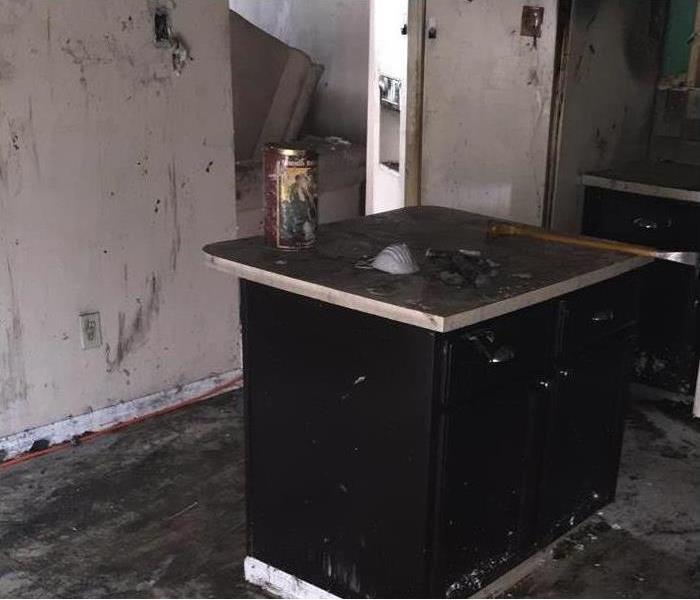 Trust the professional at SERVPRO for all of your fire restoration needs!
Trust the professional at SERVPRO for all of your fire restoration needs!
A fire in your home can be devastating causing severe damage to your structure and contents. The restoration process is complex and requires expertise in fire restoration to restore your home to preloss condition. SERVPRO of Northwest Columbus specializes in fire and water damage restoration and have highly trained professional fire restoration technicians and a full construction department to restore your home.
The restoration process will begin when you call SERVPRO of Northwest Columbus for your fire damage:
- Contact SERVPRO 24 Hours a day, 7 days a week.
- Our professional office personnel will schedule an estimator to your home to evaluate your loss and provide you with a detailed estimate.
- If any structure is compromised, we will schedule a crew to board-up or tarp your windows, roof or walls to protect against further damage and protect your home.
- When there is minimal or no structure damage, we will schedule a fire restoration technician to clean the soot from the structure and contents. Some items such as electronics and clothes will be removed and cleaned off site.
- When your fire loss is extensive and involves structure damage, you will not be able to stay in your home during the repairs and restoration. SERVPRO will pack, tag and inventory your contents and store them in our warehouse until your home is restored. Our professionally trained contents specialist will clean and re-box the contents in our warehouse.
- SERVPRO has a variety of cleaning techniques and equipment to restore your belongings to pre-fire loss condition.
- Once the soot is removed, and the demolition of affected structure is completed we will schedule our professional construction team to repair or rebuild the damaged structure.
- Your cleaned contents will be moved back to your home once the construction department has completed the rebuild.
Call SERVPRO of Northwest Columbus at 614-261-6666 with your fire restoration needs.
Preventing Grease Fires In Your Kitchen
12/30/2021 (Permalink)
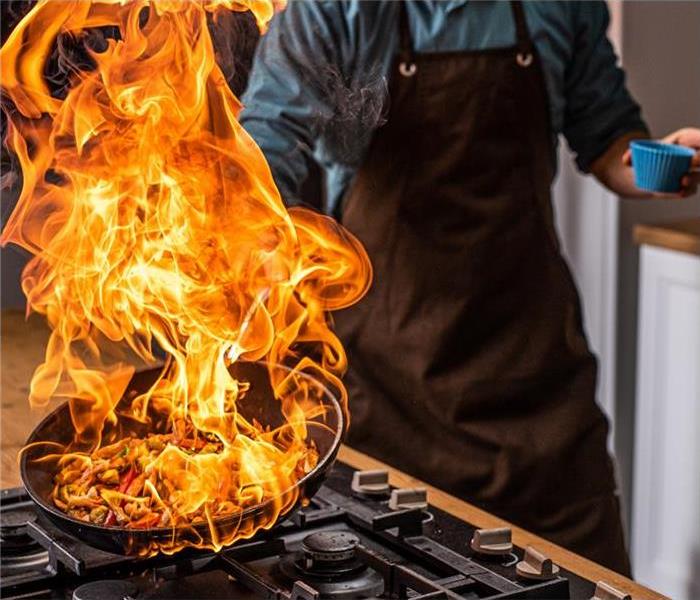 Call our SERVPRO Team for your fire restoration needs!
Call our SERVPRO Team for your fire restoration needs!
Whether you are cooking in a restaurant or in your own home, a grease fire can quickly become a big disaster. Grease fires can present themselves as a difficult issue since they are notorious for being difficult to put out.
The first reaction to a fire is to pour water on it, which for grease fires, can actually spread the fire and make it worse!! Follow the correct steps below on putting out a grease fire.
How do I put out a Grease Fire?
- Turn off the heat. Make sure to not pick up the pan. Picking up the pan can cause the fire to quickly spread to you or spill onto other surfaces in the kitchen.
- Put a lid on the pan to cut off oxygen to the fire. Once it has sufficiently cooled down, you will be to move and clean it.
- If the fire gets out of hand, make sure to call 911 to get assistance right away from the Columbus Fire Department.
- NEVER pour water on an active grease fire or fan the fire. Both of these actions will only spread the fire.
- Do NOT fan the fire with a dry or wet cloth, it can make it worse and spread the fire.
- If all else fails, use a fire extinguisher to put out the flame.
How to Prevent A Grease Fire
- Never leave your cooking unattended, always keep an eye on any pots or pans.
- Make sure that you have a sufficiently sized lid for all of your cooking ware.
- Heat the oils in your pans slowly, don't put your stove on the highest setting right off the bat.
- Turn the heat off if you think your pans are getting too hot.
Due to the nature of a grease fire, it is highly recommended that you seek out the help of a professional like SERVPRO of Northwest Columbus for fire restoration help. In addition to cleaning up any damage such as burned materials, soot, or grease, a professional can help your kitchen rid itself of the smoke scent.
Our SERVPRO of Northwest Columbus Team has the knowledge and decades of experience to help you quickly and effectively repair damage from a grease fire.
Fire Damage Services In Columbus
12/29/2021 (Permalink)
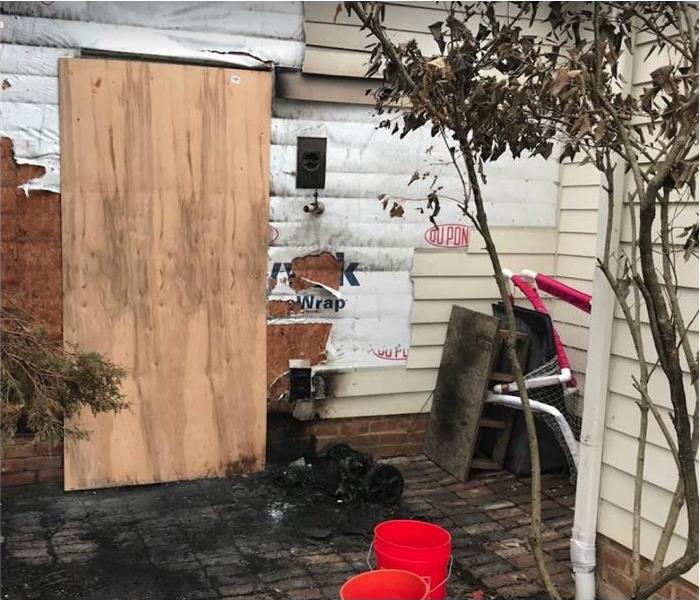 SERVPRO of Northwest Columbus boarded this home after a fire.
SERVPRO of Northwest Columbus boarded this home after a fire.
Along with providing structural cleaning, contents cleaning, and deodorization services after a residential or commercial fire, SERVPRO of Northwest Columbus also offers additional specialized services to our customers:
Board-Up
One of the top priorities after a fire loss is to secure your property and belongings until work can begin. SERVPRO of Northwest Columbus offers board-up services for windows, doors, and other exposed structural areas to prevent intrusion by both water and unauthorized persons.
Inventory, Pack-Out and Storage
As the clean up and restoration process begins, our SERVPRO of Northwest Columbus technicians take inventory of the contents in your home or business. As the contents are sorted, they will be categorized as salvageable, and processed to be cleaned, or unsalvageable, and documented as such for insurance purposes. Our professional SERVPRO Team can pack-out and store any unaffected materials as needed as well. Our SERVPRO Professionals are trained to properly inventory, move out and control the contents from the structure during the cleaning, restoration, and deodorization process.
Document Drying and Restoration
The SERVPRO Document Restoration Team offers a range of services to restore your damaged documents, including drying, cleaning/disinfecting, re-jacketing, digitizing, and deodorization. Depending on your specific needs, and utilizing industry leading techniques and state-of-the-art technology, SERVPRO’s restoration professionals will help you recover paper goods, no matter the size of the loss.
SERVPRO of Northwest Columbus is Here to Help with all your fire damage needs. Our professional team will help make it “Like it never even happened.”
Reducing Your Risk Of a House Fire
12/28/2021 (Permalink)
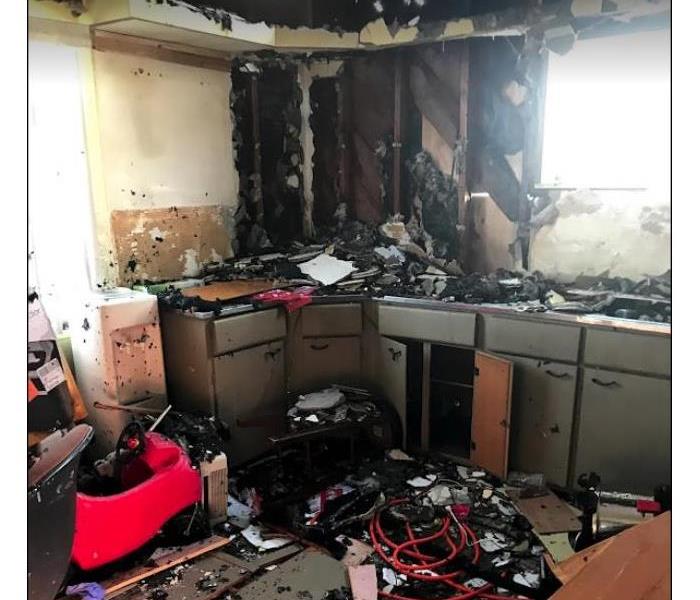 Call our SERVPRO of Northwest Columbus Team for all of your fire damage needs.
Call our SERVPRO of Northwest Columbus Team for all of your fire damage needs.
Your home is your sanctuary. A place where your family spends time together and makes memories. That’s why it is so scary imagining your home getting damaged by an unfortunate fire. Although you can’t control everything that happens in your home, there are some necessary tips you can follow to prevent a possible house fire. Follow these tips below.
- Regularly test your smoke alarms. Test your smoke alarms by pressing the button located on the smoke alarm, if it produces a weak beeping noise, it is time to replace the batteries.
- Check your heating sources. Heating sources that aren’t working properly could potentially trigger a fire. Have them checked annually.
- Maintain a clean oven and stove. Food particles left behind can get to hot on the burner or in the oven causing a potential fire. Make sure nothing is left too close to the stove that could catch fire.
- Never leave your kitchen. Don’t leave your kitchen while cooking. It only takes a few seconds for a fire to break out. If you have to step out of the room, turn the burners off.
- Check your dryer. Make sure to clean out your lint trap after every load of laundry. The build up of lint can cause a fire. Have your dryer inspected by a professional yearly.
- Inspect your cords. Before plugging something in, inspect the cord to make sure it is not frayed or been chewed. Replace the cords as soon as possible if you notice that the wires have been damaged. Avoid running cords under a rug or between the wall and your furniture, it can get too hot causing a fire.
- Store flammable products properly. Store common household cleaners and cosmetic items in a cool area. If they are exposed to high heat, they can combust.
- Use caution with candles. Put candles out before you leave the room or go to sleep and make sure to keep them far away from blankets or any other objects that could catch fire. Place candles on an even surface to prevent them from being knocked over. Also keep them away from pets.
- Use caution with your fireplace. Make sure there is a door between the flames and your flooring, you don’t want any sparks to escape. Allow enough time for the ashes to cool down before throwing them away.
- Always have a fire extinguisher handy. When a fire breaks out, your best line of defense is a fire extinguisher. Make sure every family member knows how to use it properly in case of a fire.
Your Pretty Holiday Lights Can Cause Damage To Your Home
12/1/2021 (Permalink)
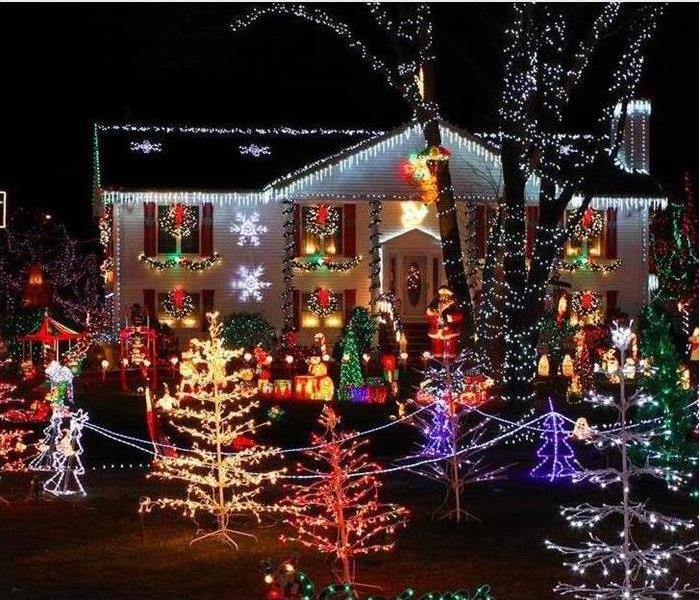 If you experience a fire due to holiday lights, call SERVPRO of Northwest Columbus today!
If you experience a fire due to holiday lights, call SERVPRO of Northwest Columbus today!
Putting up holiday lights on the outside of your home can be pretty to look at but there are safety tips you should follow to ensure the pretty lights don't end up damaging your home.
- Inspect the light strings. Throw away any strings of light if they are damaged. Frayed or cracked electrical cords or broken sockets are big fire hazards.
- Replace burned out bulbs. Empty sockets can cause the entire string to overheat causing a potential fire.
- Outdoor lighting is UL-Rated for external use. Exterior and interior lights are not the same. Exterior lights should be weather resistant. The same follows with extensions cords being used outdoors.
- Don't nail or staple light strings. Attaching light strings by nailing or stapling them can cut through the wire insulation, creating a fire hazard. Use only UL approved hangers.
- Take down exterior lights within 90 days. The longer you have your lights up, the more likely they are to suffer damage from weather or critters chewing on them.
- Safely store lights during off season. Tangled lights can lead to damaged cords and broken sockets. When you are putting your lights away, coil each string loosely around a stiff piece of cardboard, wrap them in paper, and store them in a sturdy container to protect the bulbs.
What Are Soot Tags?
11/30/2021 (Permalink)
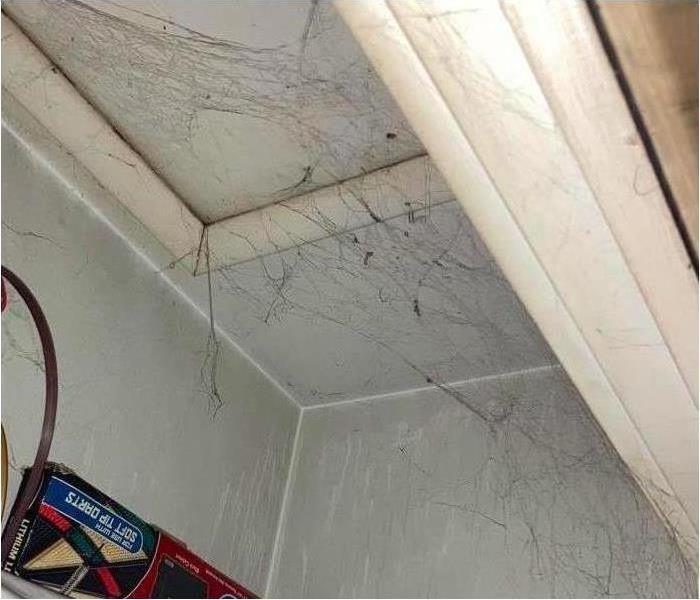 Here is an example of soot tags. You can see how closely they resemble spider webs.
Here is an example of soot tags. You can see how closely they resemble spider webs.
As fire damage specialists, we see a lot of fire damaged residential homes and commercial properties. The damage can either be extensive or very minimal. One of the most common visible instances of fire damage are soot webs, the technical term for them are "Soot Tags". They look exactly like spider webs. Rest assured, you did not have magical "fire spiders" that created these cobwebs in your home.
Soot Tags form in areas of low circulation when petroleum/synthetic based sources burn. During a fire the heat of the fire moves into colder areas since the air seeks to create equilibrium. The soot then rides in the air with the heat particles that follow the air into those colder areas with low circulation and are able to concentrate. Since that soot is a product of combustion the particles themselves are charged which makes it quite easy for them to create long chains of soot or soot tags. So while it looks like a lot of soot got stuck on pre-existing spider webs it is actually a whole new structure.
If you notice that you have soot tags in your home or business after a recent fire, do not try to clean it up yourself. Any time you try to clean soot without the proper chemicals, tools and experience, you’ll likely cause further damage in your home. That's why our SERVPRO of Northwest Columbus Team is here to help, we are the fire damage restoration specialists at your service 24-7!
Smoked Damaged Homes
2/5/2021 (Permalink)
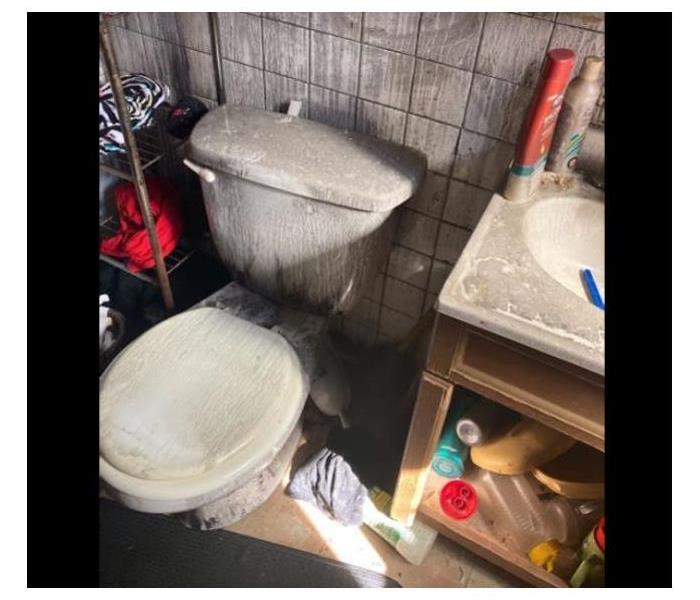 Here is an example of soot covering the entirety of this bathroom after a fire.
Here is an example of soot covering the entirety of this bathroom after a fire.
Not every fire results in an extensive amount of damage to homes. In fact many fires don’t require a large amount of demolition and rebuild; especially ones caused by cooking accidents. Grease fires, protein fires, contained fires or outdoor fires can all do a small amount of damage to homes but they can produce a lot more smoke and residue than homeowners realize.
That smoke, soot, and residue will go throughout your Columbus home covering all types of surfaces such as walls, counter-tops, cabinets, contents, and clothes. Smoke damage often leaves behind sticky residue, stains surfaces, odors, and can be toxic to breath long term especially for those with respiratory issues. The residue is not always visible either which is why the testing process is very important.
A home does not need to be severely damaged after a fire for you to call one of our experts for a free inspection of your home. The size and scope of damage after a small fire can be very surprising to many homeowners when our SERVPRO technicians do the inspection and show how far reaching smoke damage can be and what all is affected. In our inspection we use various cleaning tools and chemicals to determine the best way to restore your home to its before fire condition.
If you experience a fire in your Columbus home give our SERVPRO of Northwest Columbus experts a call today!
What To Expect After A Fire
12/29/2020 (Permalink)
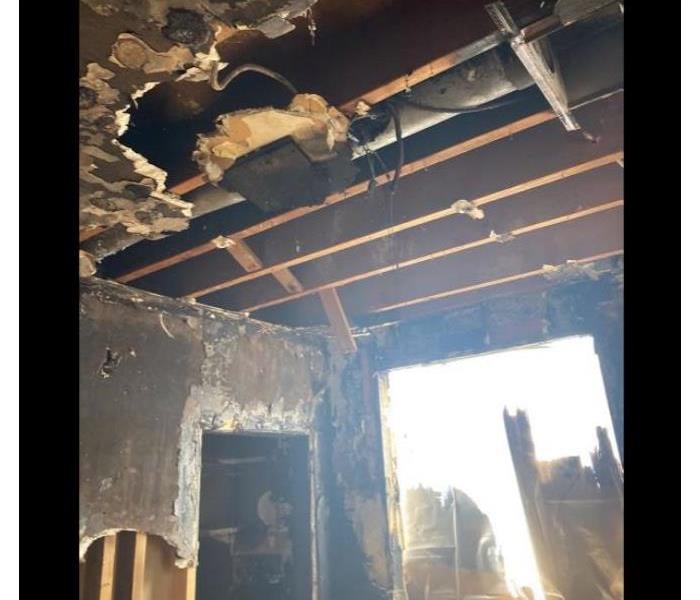 Call our SERVPRO Team for assistance after a fire!
Call our SERVPRO Team for assistance after a fire!
A fire damage event is difficult for the home or business owner on many levels, and the restoration process that follows can be intimidating. Each fire event is a little different, and each will require a unique solution, although the overall general process stays the same. The steps we are listing below will illustrate the SERVPRO process for the average fire damage emergency.
- Emergency Contact. Your restoration process begins the moment that you contact us. Our representative will ask you questions regarding the fire damage event that will help us to respond with the appropriate equipment and resources for your particular situation.
- Inspection and Fire Damage Assessment. Our team will carefully inspect and test all the adjoining rooms of your home or business to determine the extent of the fire, smoke, and soot damage. This step is vital to us, allowing us to develop the perfect plan of action for your property.
- Immediate Board-Up and Roof-Tarp Service. Fire damage will often compromise the condition of windows, walls, and roofing. To maintain security and to protect against further damage, we will board up missing windows and walls, and place tarps on damaged areas of the roof.
- Water Removal and Drying. If water damage is present, the water removal process will begin almost immediately, with the goal of removing the majority of the water. Our team will then employ dehumidifiers and air movers to remove any remaining water and complete the drying process.
- Removal of Smoke and Soot From All Surfaces. SERVPRO uses specialized equipment and techniques to remove smoke and soot from ceilings, walls, and all other surfaces.
- Cleaning and Sanitizing. We clean, sanitize, and disinfect all of the restorable items and structures that were damaged by the fire. Our team uses a variety of cleaning techniques to restore your belongings to the condition they were in before the fire. We are also trained to remove lingering odors, using industrial air scrubbers and fogging equipment.
- Restoration. This is the final step - getting your home or business back to its pre-fire condition. Restoration may involve minor repairs, such as replacing drywall, installing new carpet, or painting surfaces, or it may entail major repairs, such as the reconstruction of various rooms or areas.
Here at SERVPRO of Northwest Columbus, we are here to help if your Columbus home or business suffers from damage due to a fire.
How To Handle Fire Damage In Your Home
11/11/2020 (Permalink)
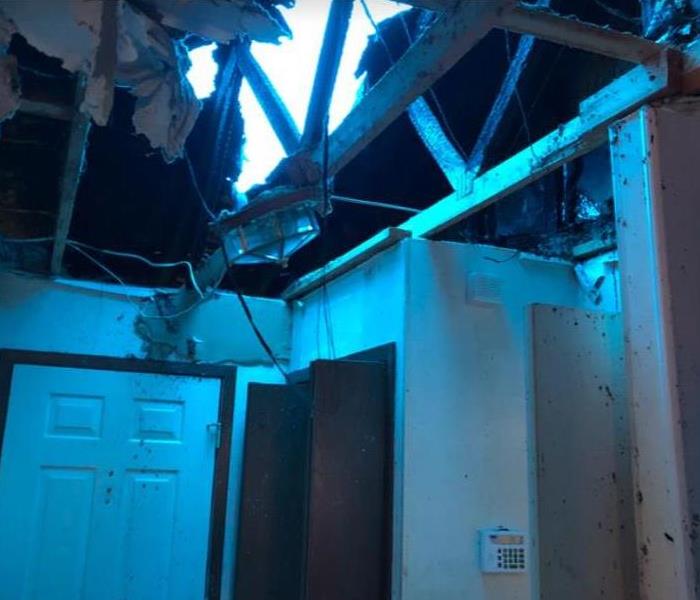 Our SERVPRO Team has the knowledge and tools to restore your home after a fire.
Our SERVPRO Team has the knowledge and tools to restore your home after a fire.
You may think that your Columbus home is not vulnerable to a fire, but evidence shows that unexpected home fires can happen very quickly and when you least expect it. A kitchen grease fire or an electrical short can damage your home in just a few minutes. Very often, the fire burns in only one section of the house, but the smoke travels farther out than where the source of the fire is. However, even the smallest of fires require professional attention.
Here at SERVPRO of Northwest Columbus, we specialize in fire restoration services for Columbus homeowners. We coordinate the repairs and continually communicate with your insurance adjusters to make your restoration process as easy as possible. Our SERVPRO Team is available around the clock to minimize the time in which your home and its contents continue to absorb soot, smoke, and any extinguishing agents used to put out the fire.
Call Your Local Fire Restoration Team to Restore Your Home in Columbus
We recommend you let our SERVPRO team take a look at the damage in your home. It is best to have our knowledgeable team use the latest technology available in our field to inspect your home. Using tools such as hygrometers and infrared camera imagery, we can detect where water might be hiding in places such as subfloors and within wall cavities. Similarly, we inspect your ventilation system and follow the smoke path to determine how to mitigate the odor it left behind. This thorough assessment focuses on protecting you from developing an environment where your home or health could be compromised. Among the actions we can take to remove traces of the fire we include the following:
- Use thermal foggers or hydroxyl generators to combat the pungent smell
- Discard items, particularly porous textiles that might pose a danger to your health. Upholstery and carpets are especially vulnerable to being damaged beyond repair
- Application of industrial-strength cleaning agents to remove stains and soot throughout your home
Candle Safety And Alternatives
11/11/2020 (Permalink)
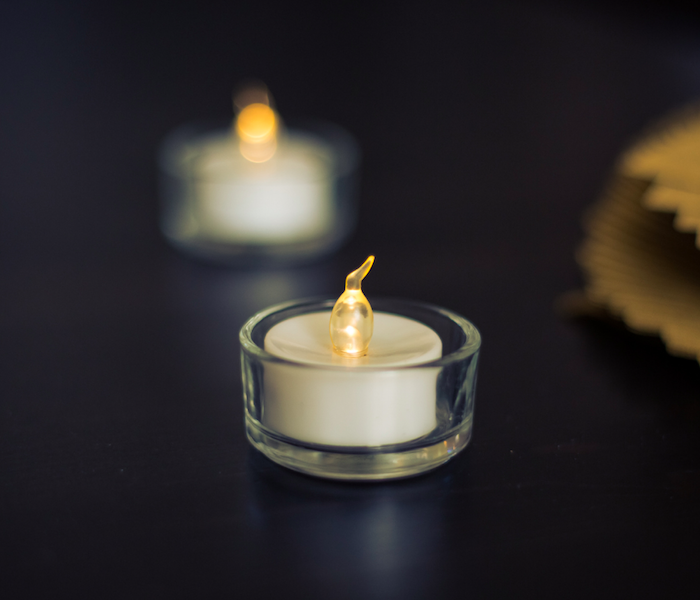 Candles can be dangerous, consider the alternatives!
Candles can be dangerous, consider the alternatives!
We all love candles. They are pretty to look at and get your home smelling wonderful. But unfortunately we need to remember that a candle is an open flame and can easily catch its surroundings on fire causing your beloved home to go up in flames.
First, lets take a look at the candle fire facts from the National Fire Protection Association to see just how common a candle fire is.
- There are 21 candle fires reported per day on average.
- Candles cause 2% of reported home fires, 3% of home deaths, 6% of home fire injuries, and 4% of the direct property damage in house fires.
- 37% of home candle fires start in the bedroom.
- 11% of the candle fires were a result of falling asleep while a candle was still burning.
- 60% of candle fires occurred when a flammable item was too close to the candle.
Fortunately, there are many great candle alternatives that make your home smell great or create a relaxing ambiance.
1. Battery-Powered Candles
While electric candles may not look or smell exactly like the real thing, they are a safe alternative to get the same ambiance. Plus, you don't need to worry about remembering to turn them off when you leave the room or house. You won't come home to an unexpected fire disaster.
2. Wax Warmers
These help spread the fantastic smell of melted wax through your home by using a wax warmer. These candle alternatives use battery power or electricity instead of an open flame to heat up the wax.
3. Fairy Lights
If your main goal is to add relaxed lighting to your home rather than release a scent into the air, fairy lights a great way to quickly light up a room or outdoor area. Fairy lights may be powered by battery or electricity, making them a much longer-lasting option than a candle.
4. Essential Oil Diffusers
Essential oils can help add a scent to the room and might benefit your health too. There are many different diffusers to choose from, so you can easily find one that matches your home.
We Are Here To Help After A Fire
11/10/2020 (Permalink)
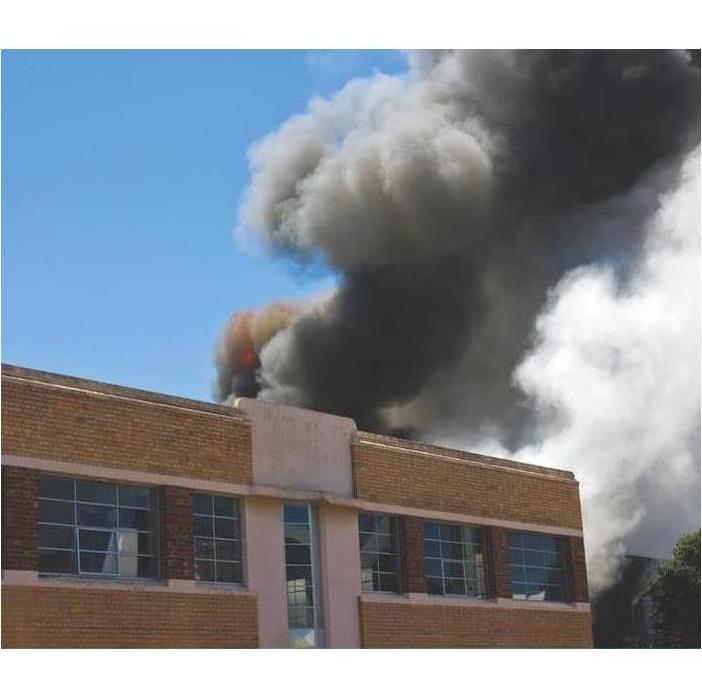 Call our SERVPRO Team today!
Call our SERVPRO Team today!
Our SERVPRO Team knows that even the smallest of fires can create large amounts of smoke damage, and that damage isn’t just confined to the area of the fire. SERVPRO of Northwest Columbus understands that when your business or commercial property has been affected by a fire, you need help fast. When you call our SERVPRO Team, our highly trained professionals will be on site quickly to assess the damage and begin the process of getting your building up and running.
As small business owners, we understand that every hour you spend cleaning up after a fire means lost revenue and productivity. Our goal is to clean and restore your structure and contents quickly and efficiently so you can get back to doing what your business and building does best.
If your business or commercial property has been impacted by fire or smoke damage, call SERVPRO of Northwest Columbus anytime, day or night at 614-261-6666. We are here to help you 24-7. Our SERVPRO Team makes your building "Like it never even happened."
Small Fires Cause Larger Damage
11/10/2020 (Permalink)
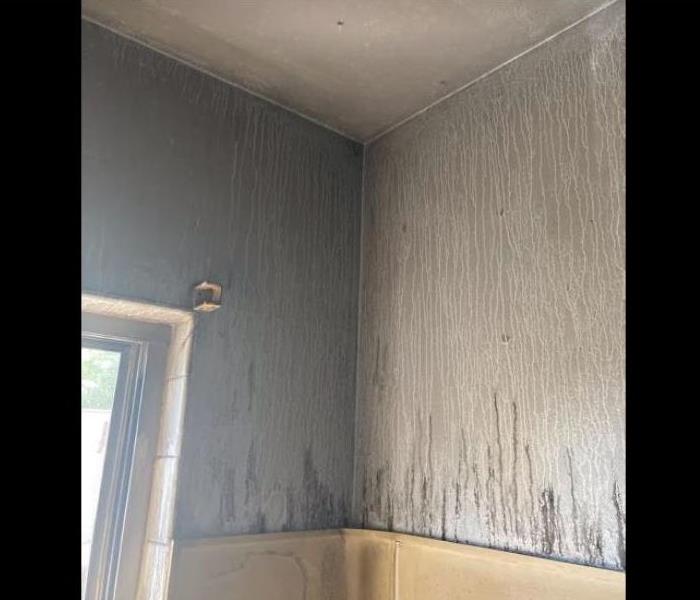 A house fire caused significant soot build up throughout the rest of the home.
A house fire caused significant soot build up throughout the rest of the home.
Fire accidents in the home happen quite frequently. There are many things that cause house fires including cooking accidents, which is the most common, lightning strikes, candles, smoking mishaps, heaters, fireplaces, electrical issues, dryer vents, and other household appliances.
Did you know? In less than 30 seconds a small flame can turn into a major fire. Within minutes it creates thick black smoke engulfing the house in flames. That is why it is important to have a fire extinguisher on hand and if possible extinguish the flames. Every second counts.
In most cases, you can put out the flames quickly and the damages are minimal. But even a small fire can causes larger amounts of damage to the rest of your home. Often times, it is only one room that is completely charred but the damages go beyond that room. Smoke from a fire can fill your whole house and circulate throughout several rooms. Smoke damage occurs when the acidic ash or chemicals react with metal, plastic, or wood. Smoke can permeate carpet and other soft surfaces such as fabrics, drapes, and clothing. Our team always tries to restore your belongings before replacing them becomes an option.
SERVPRO of Northwest Columbus is your go to company that is well equipped to handle any size fire damage. Our SERVPRO Team follows IICRC Standards when restoring your home. Our trained professional state of the art equipment to return your home to it's pre-fire damage condition "Like it never even happened."
How To Avoid A Contact Burn
2/4/2020 (Permalink)
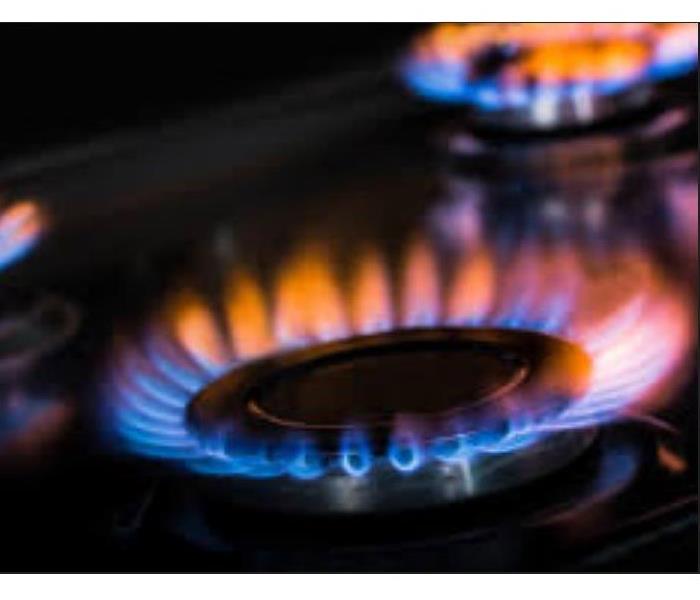 Beware of the hot stove!
Beware of the hot stove!
This week is National Burn Awareness Week and SERVPRO of Northwest Columbus wants to make sure you and your family are safe when it comes to hot surfaces and objects. Follow the tips below!
DID YOU KNOW?
- According to the National Electronic Injury Surveillance System, in 2018 roughly 70,000 people went to the hospital emergency department because of contact burns.
- About one-third of the patients were children under the age of five
TIPS
- Supervise children around hot objects at all times.
- Stand at least 3 feet away from hot outdoor objects. Keep area clear of trip hazards. Limit alcohol consumption.
- Protect your feet from hot objects by wearing shoes when walking on hot pavement or sand. Keep pets off hot pavement too.
- Turn heating pads and blankets off before sleep.
- Have hot pads available whenever cooking. Long oven mitts are best when needing to reach in or over hot surfaces, such in an oven or over a grill. Assume all pots and pans are hot.
- Remember to treat items coming from the microwave as you would items from the oven. Limit microwave use by children.
- Unplug tools such as these when not in use, and always treat as if they are still hot. Keep out of reach of children.
Power Strip Safety
12/31/2019 (Permalink)
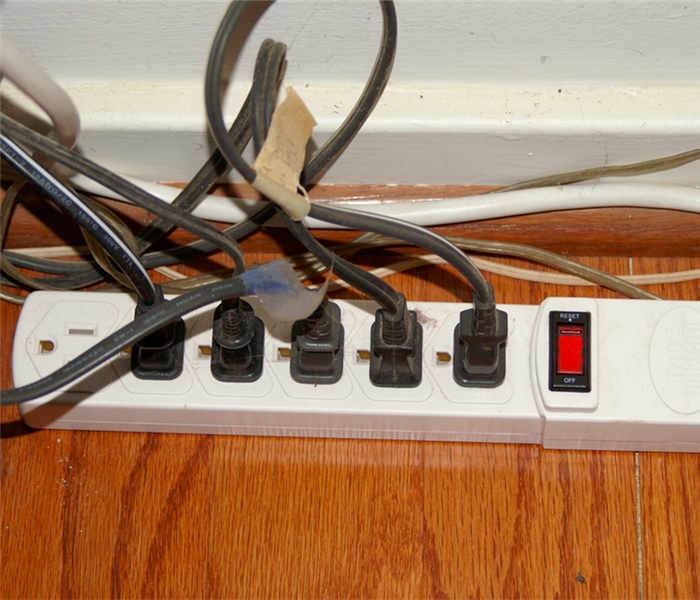 If you experience an electrical fire from a power strip, call SERVPRO of Northwest Columbus for help.
If you experience an electrical fire from a power strip, call SERVPRO of Northwest Columbus for help.
With the endless amount of accessories, appliances, and tools that are becoming more and more common in your household, it can sure be a hassle figuring out where to plug all of them in at. Many homeowners find themselves always swapping plugs or using devices such as a power strip. While a power strip can help you out in many situations, it is the mistake of relying on them too much that causes problems. Follow these tips below to ensure your safety when using a power strip in your home.
- Use only light load appliances on power strips. That includes computers, lamps, clock, etc.
- Ensure that the power strip you purchase has an internal circuit breaker. This is a very important safety measure that is designed to prevent property loss and risks of fire.
- Use power strips sparingly. They aren't designed to maintain a load for an extended period of time, and can easily overheat quickly if used to often.
- DON'T plug a power strip into another power strip (term is called "daisy chaining"). Doing this will short out appliances and highly increase the risk of an electrical mishap.
- DON'T use power strips in moist or potentially moist areas. DON'T put them in kitchens, utility rooms or basements.
- DON'T continue to use a power strip if it feels hot.
- NEVER cover, staple, tack or nail a power strip to anything. Covering can smother the strip, and provide ample flammable material in the event of a power strip failure. Puncturing can harm the cords, making room for dangerous situations.
Fireplace Safety
11/7/2019 (Permalink)
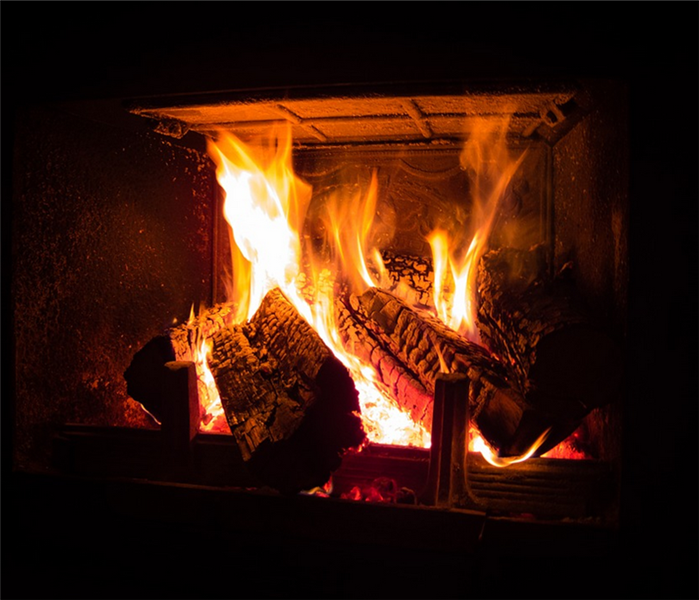 Call SERVPRO of Northwest Columbus if you experience a fire in your home.
Call SERVPRO of Northwest Columbus if you experience a fire in your home.
As the weather starts to get colder outside, you and your family often look for ways to stay warm inside, such as gathering around the fireplace. Unfortunately, fireplaces can be dangerous. Follow these tips to keep your family and home safe.
- Keep a nearby window cracked open while the fire is burning, if possible.
- Make sure the damper or flue is open before starting a fire. This allows the smoke to be drawn out of the house. You can check the damper by looking up the chimney with a flashlight. Do not close the damper until the embers have stopped burning completely.
- In the fire, use dry and well-aged wood. Wet wood produces more smoke and contributes to soot buildup in the chimney. When the wood is dry it burns more evenly and produces less smoke.
- Before starting a fire, clean out the ashes from any previous fires. The level of ash at the base of the fireplace should be 1 inch or less. Thicker layers of ash restrict the air supply to the logs, resulting in more smoke.
- The chimney should be checked by a professional annually.
- Even if your chimney is not due for cleaning, it is important to check for any blockages that could prevent smoke escaping.
- Clear the area around the fireplace of anything that is potentially flammable. If these items get too close to the fireplace, they could catch fire.
- If you have a switch on the wall that turns on your fireplace, consider covering the switch to prevent children from turning the gas or fireplace on.
- Never leave an active fire in the fireplace unattended. Before going to bed or leaving the house, make sure the fire is completely out. Never leave children unattended around a fire.
- Place fireplace tools and accessories out of reach of children.
- Always have smoke and carbon monoxide detectors located throughout your home. Test them monthly and change the batteries at least once a year.
- Always keep a fire extinguisher on hand.
Removing Soot From Your Home
11/7/2019 (Permalink)
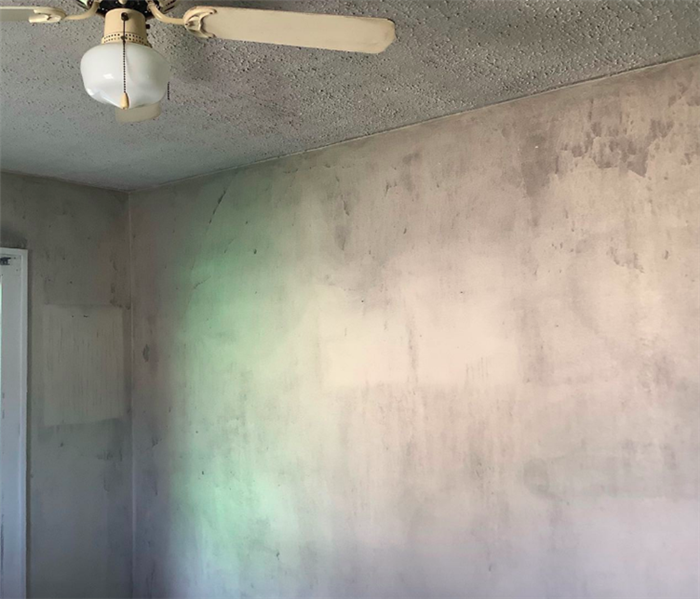 This soot damaged wall was caused by fire due to faulty electrical wiring.
This soot damaged wall was caused by fire due to faulty electrical wiring.
As the temperature continues to drop, we often looks for ways to keep warm inside our homes. Whether that be to light candles, have a fire in the fireplace, or use a space heater. Unfortunately these heath sources can cause a fire if not monitored correctly. A fire then produces soot, a black residue that is left behind when various materials are burnt such as plastics, synthetics, foam and wood. Soot can have damaging effects on your home. While it is advised to leave it to the professionals to clean up soot, you can make the cleanup process easier by following these safety guidelines.
- During the first inspection of a soot damaged room, refrain from touching anything. This prevents soot to from getting in areas that were unaffected.
- The best method for soot cleanup is by using dry-cleaning sponge or chemical dry sponge. If you attempt a wet method, the soot will smear, leaving behind a hideous stain.
- Always wear protective gear, such as masks, gloves, and long clothing that covers the skin.
- To minimize the inhalation of soot particles, keep the room properly ventilated.
- For easier cleanup, clear the room of unnecessary debris.
- Use proper cleaning methods when removing soot from the walls. Most homeowners think soap and water will do the trick but improper cleaning can cause the damage to spread or get worse.
When in doubt, call the professionals here at SERVPRO of Northwest Columbus.
Watch Out For Fire Damage From Your Clogged Dryer Exhaust Duct
10/28/2019 (Permalink)
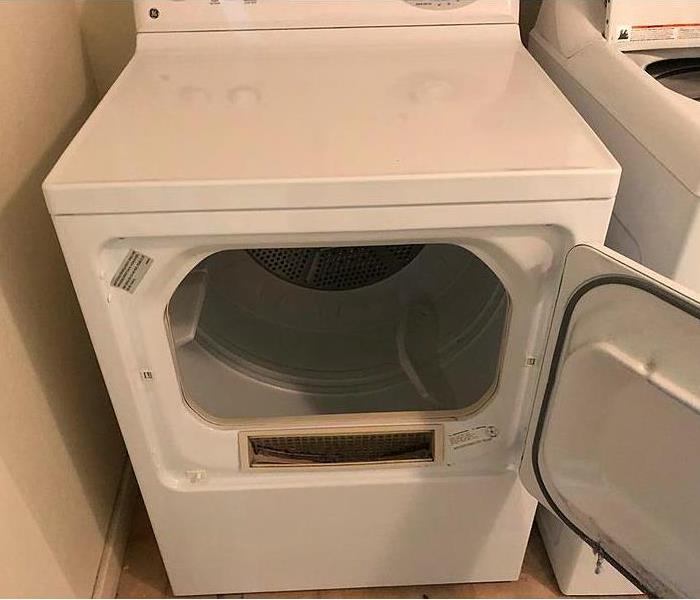 Have Your Dryer Checked To Prevent A Fire
Have Your Dryer Checked To Prevent A Fire
Most of us don’t think about maintenance on our clothes dryers, but we should! The U.S. Fire Administration reports that every year there are thousands of home fires started by clothes dryers. Lint and debris can build up in your dryer vent, reducing air flow to the dryer, backing up dryer exhaust gases, which can result in a fire hazard. It is recommended you have your dryer exhaust system cleaned at least twice a year.
How to tell if you dryer vent is clogged
- Normal drying cycle is not drying clothes
- If it takes more than 40 minutes to dry a load of clothes
- Clothes smell musty after normal cycle
- Clothes are hotter at the end of the cycle
- Large amount of lint accumulates in the lint trap
- Your laundry area is more humid
- Burnt smell in your laundry room
- Outside dryer vent cover is not lifting
What you can do to reduce the risk
- Clean your lint filter after each load of clothes
- Use dryer sheet and fabric softener sparingly
- Remove the back of the dryer to vacuum out lint that is trapped
- Keep area around dryer free of dust and debris
- The duct line that vents outside should be as short as possible
There are tips online on how to clean you dryer vent system, but it is recommended you hire a professional. The cost is $100 - $150 depending on the length and location of the vent. In addition to the reduced threat of fire, a cleaning can pay for itself in less than a year through the improved efficiency with less drying time required.
SERVPRO of Northwest Columbus is here for you should you do have a loss from a dryer vent fire. Please call 614-261-6666 for help.
Four Stages Of A Fire
10/28/2019 (Permalink)
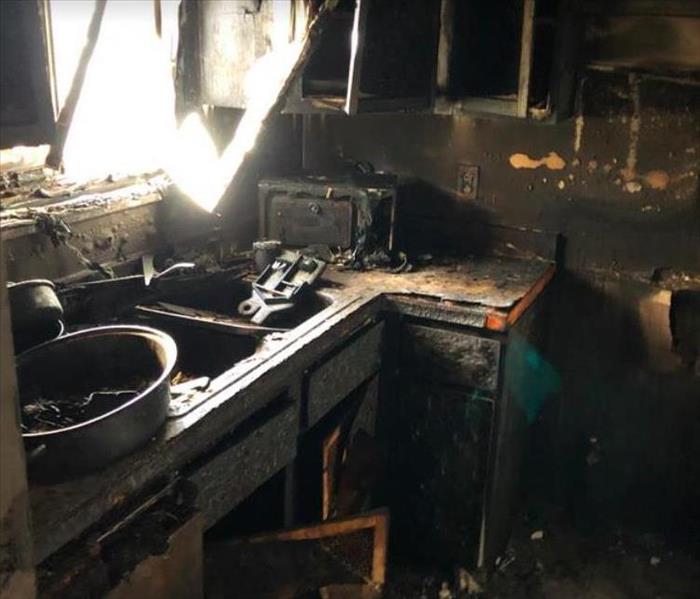 Call SERVPRO of Northwest Columbus at 614-261-6666 if you experience an unexpected fire
Call SERVPRO of Northwest Columbus at 614-261-6666 if you experience an unexpected fire
A fire in your home or business never something you expect to experience. Which is why it is important to know the 4 stages of a fire to keep you safe.
Incipient: This first stage begins when heat, oxygen and a fuel source combine, having a chemical reaction resulting in a fire. It is also known as “ignition”. There is usually a small fire, which often goes out on its own, before the following stages are reached. During this stage, recognizing a fire so early is your best chance at suppression or escape.
Growth: This stage is where the structure’s fire load and oxygen are used as fuel for the fire. During the growth stage, there are multiple factors that affect the fire including where the fire started, what combustibles are nearby, ceiling height and the potential for “thermal layering”. This is stage is when a deadly “flashover” can occur’ potentially trapping, injuring, or killing firefighters.
Fully Developed: When the growth stage has reached its maximum and all nearby combustible materials have been ignited, the fire is considered fully developed. This is the hottest stage of a fire and the most dangerous for anyone trapped within.
Decay: The decay stage is the longest stage of a fire; it is characterized by a significant decrease in oxygen or fuel, putting an end to the fire. There are two common dangers during this stage. First, the existence of non-flaming combustibles that can potentially start a new fire if they are not fully extinguished. Second, there is a danger of a backdraft when oxygen is reintroduced to a volatile, confined space.
How To Use A Fire Extinguisher
9/25/2019 (Permalink)
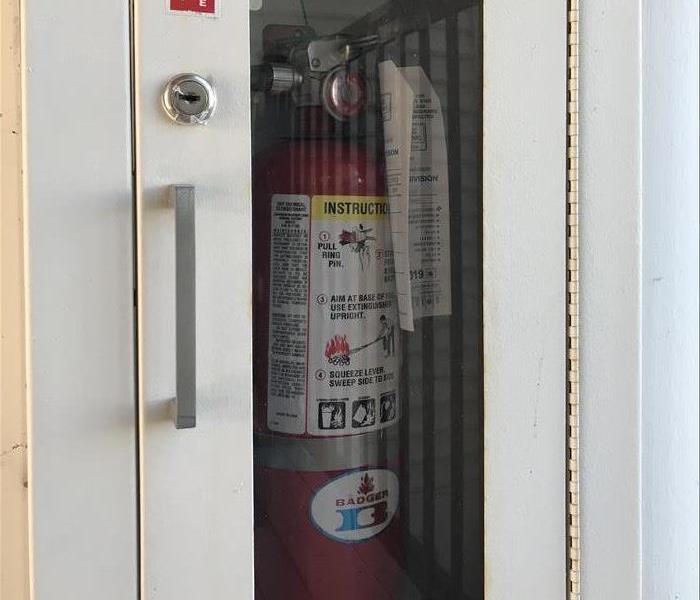 Fire extinguishers are required to be in every home, building and business to ensure our safety.
Fire extinguishers are required to be in every home, building and business to ensure our safety.
Fire Extinguishers are everywhere, but do we actually know how to use them. The majority of Americans admit to not knowing how to use a fire extinguisher even if they have one in their home. That is scary to think about considering a fire doubles every 60 seconds. You don’t want to be fumbling around reading instructions while your home is going up in flames. Follow the steps below to properly extinguish a fire.
Use the P.A.S.S. Technique
1. PULL → Pull the pin, breaking the tamper seal.
2. AIM → Aim low, point the nozzle of the fire extinguisher at the base of the fire.
3. SQUEEZE → Squeeze the handle to release the extinguishing agent.
4. SWEEP → Sweep from side to side at the base of the fire until the fire appears to be out. Carefully watch the area. If the fire reignites itself, repeat steps 2 through 4.
How To Prevent Kitchen Fires In Your Home
9/10/2019 (Permalink)
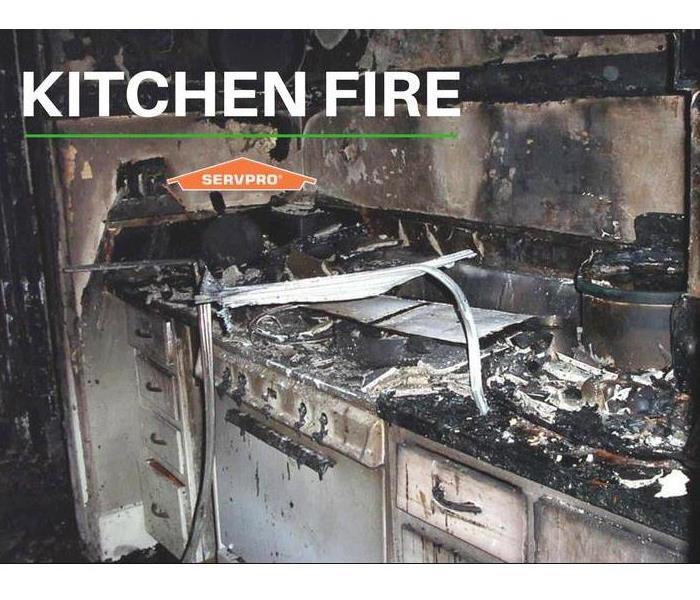 Getting the right information, customers can prevent kitchen fires in their own homes, keeping their families and homes safe.
Getting the right information, customers can prevent kitchen fires in their own homes, keeping their families and homes safe.
Did you know that cooking fires are one of the main causes of home fires! Even though you can’t prevent every source of a kitchen fire, you can minimize fire risks with knowing the right information. Follow these fire prevention tips to reduce your chances of a kitchen fire and keep you and your kitchen safe.
- Make sure your appliances are always serviced, clean, and in good repair. Wipe down the microwave. Clean the oven. Dump and clean the crumb tray in toasters and toaster ovens. Unplug appliances that start acting strange, and then have them repaired or replaced.
- Unplug any electric appliances that are not in use. Toasters, blenders, coffee makers, and any other appliances continue to draw electricity to them, even if they are not turned on. If the wiring is old or faulty, a fire could break out.
- Install a smoke detector near the kitchen. A small amount of smoke will constantly trigger the alarm if the smoke detector is directly in the kitchen. Installing the smoke detector near the kitchen will pick up the heavy smoke when needed.
- Use caution when lighting a burner on a gas stove. Make sure to read the manufacturer’s instructions.
- Don’t put metal in the microwave. Metal can cause sparks that could then turn into a fire or do heavy damage to your microwave.
- Don’t overfill pots and pans with oil or grease. Hot oil or grease can splatter causing a fire.
- Wipe up any spills and never cook on a dirty stove. Grease buildup is very flammable. Having a clean stove is a fire free stove.
- Roll up your sleeves and tie back your hair when cooking. Baggy clothing and long hair can easily get in the way while cooking, causing you to get hurt.
- Don’t take your eye off of cooking food. Always stay in the kitchen when you are cooking, especially if you are cooking grease or if the oven is at a very high temperature. If you need to leave the house, make sure to turn off the oven and any burners you had on.
- Keep all dishtowels, potholders, and paper towels away from the stove. If you leave a burner on, the built up heat can ignite combustible near the stove area.
If you experience unexpected fire damage in your home, call SERVPRO of Northwest Columbus at (614) 261-6666.
Worthington Smoke and Soot Cleanup
6/2/2016 (Permalink)
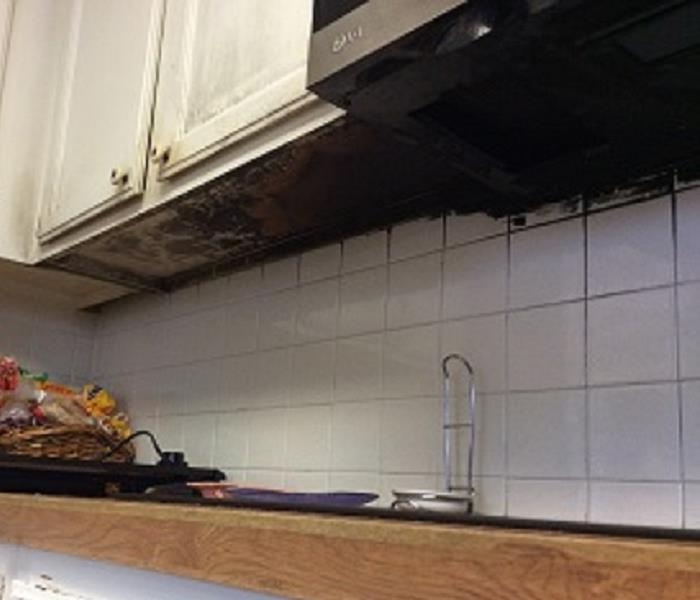 Smoke and Soot Damage Can Cause a Pervasive Odor in Your Worthington Home.
Smoke and Soot Damage Can Cause a Pervasive Odor in Your Worthington Home.
Smoke and soot is very invasive and can penetrate various cavities within your home, causing hidden damage and odor. Our smoke damage expertise and experience allows us to inspect and accurately assess the extent of the damage to develop a comprehensive plan of action.
Smoke and soot facts:
Hot smoke migrates to cooler areas and upper levels of a structure.Smoke flows around plumbing systems, seeping through the holes used by pipes to go from floor to floor.The type of smoke may greatly affect the restoration process.Different Types of Smoke
There are two different types of smoke–wet and dry. As a result, there are different types of soot residue after a fire. Before restoration begins, SERVPRO of NW Columbus will test the soot to determine which type of smoke damage occurred. The cleaning procedures will then be based on the information identified during pretesting. Here is some additional information:
Wet Smoke – Plastic and Rubber
Low heat, smoldering, pungent odor, sticky, smeary. Smoke webs are more difficult to clean.Dry Smoke – Paper and Wood
Fast burning, high temperatures, heat rises therefore smoke rises.Protein Fire Residue – Produced by evaporation of material rather than from a fire
Virtually invisible, discolors paints and varnishes, extreme pungent odor. Our Fire Damage Restoration Services
Since each smoke and fire damage situation is a little different, each one requires a unique solution tailored for the specific conditions. We have the equipment, expertise, and experience to restore your fire and smoke damage. We will also treat your family with empathy and respect and your property with care.
Have Questions about Fire, Smoke, or Soot Damage?
Call Us Today – 614-888-5700




 24/7 Emergency Service
24/7 Emergency Service





















